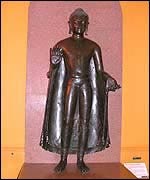Antique Buddha idol worth Rs.25
crore recovered
September 24th, 2009 - 2:15 pm ICT by IANS
Lucknow, Sep 24 (IANS) An antique idol of Lord Buddha weighing
25 kg and costing Rs.25 crore in the international market has
been recovered by police in Uttar Pradesh's Sultanpur district,
officials said Thursday
Pretending to be customers, personnel of the special operations
group (SOG) approached three people in Sultanpur — who are
now under arrest — and struck a deal with them, said Inspector
Dhirendra Shukla of the SOG. The idol, estimated to be about 300
years old, is made of ashta dhatu (eight metals).
"We had information about a gang involved in stealing ancient
idols from temples and selling them to international smugglers.
Based on this, we posed as customers and struck a deal at Rs.10
crore. The trio was arrested Wednesday night when they came to
deliver the idol to us," Shukla told IANS over the phone.
The Archaeological Society of India (ASI) has taken samples to
ascertain exactly how old the idol is.
Antique Buddha idol worth Rs.25 crore recovered
The Sultanganj Buddha

The Sultanganj Buddha is the largest metal figure of its kind
in the world, and has been housed in Birmingham Museum and Art
Gallery since 1867.
Gallery Three of Birmingham Museum and Art Gallery is devoted
to celebrating the sculptural heritage of Buddhism, Jainism and
Hinduism, three great religions that originated in India.
Complementing the Sultanganj Buddha are other objects from Birmingham
Museum and Art Gallery's collections as well as from the internationally
renowned collections of the Victoria and Albert Museum and the
British Museum.
The magnificent copper statue of the Buddha which is the centrepiece
of this gallery, is among the most significant objects in Birmingham
Museum and Art Gallery. Dated between 500 to 700 AD it is the
largest metal figure of its kind in the world.
How the Sultanganj Buddha came to Birmingham
The discovery of the Buddha in 1862
The Sultanganj Buddha was discovered during railway construction
in the North Indian town of Sultanganj in 1862. Needing ballast
for their line, engineers noticed an immense brick mound. Excavation
showed it to be a Buddhist monastery containing many valuable
artefacts.
The Buddha, however, only narrowly avoided the melting pot, thanks
to the interest of Birmingham metal manufacturer Mr Samuel Thornton
who, on hearing of the discovery, paid £200 to have it transported
to Birmingham. In 1867 the Sultanganj Buddha was put on exhibition
in the Museum.
The Sultanganj Buddha in detail
 The
Sultanganj Buddha
The
Sultanganj Buddha
The Sultanganj Buddha is 2.3m high and 1m at its
widest point and weighs about 500kgs. It was cast by the technique
known as the 'lost wax' process, in which a solid core of clay
is overlaid with wax. The sculptor models the fine details in
the wax coating.
The wax is covered with a liquid layering of clay and plaster
which hardens to form a mould. When heat is applied the wax melts
and molten metal is poured in.
The finished statue is finally obtained by removing
the outer casting when cool.
Gupta Style
The Sultanganj Buddha is a splendid example of the
renowned Gupta sculptural style which itself had been shaped by
European and Persian influences that came to India through the
trade routes with Rome and West Asia.
Sultanganj Buddha with hand raised in abhayamudra
The Sultanganj Buddha conveys an image of calm and tranquillity
and a spiritual detachment from the material world.
The Buddha's sangathi (monastic robe) clings so
closely to the body that it is almost invisible, but for a series
of string-like folds, giving the figure a wet-looking appearance.
The right hand is raised in abhayamudra (a gesture
of reassurance or protection) while the left hand, with palm outward
and held downwards indicates the granting of a favour.
http://www.bbc.co.uk/birmingham/content/articles/2006/05/10/sultanganj_buddha_feature.shtml